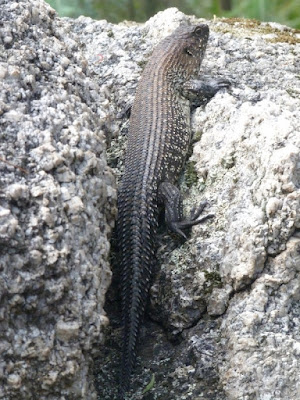When I arrived in Canberra to live over 40 years ago, Tidbinbilla was well established as a place you took your visitors, especially if they were from overseas - as many were, be they diplomats, academics, scientists, government officials or tourists. Canberra is the national capital after all and 'Tid' is just 40 km from the city centre. Back then of course it was much more of a rural drive - the suburbs have marched much further south in the intervening decades, but despite periodic pressures it's hard to imagine any government daring to allow the urban tide to cross the Murrumbidgee River.
Despite being familiar to so many generations of Canberrans, Tidbinbilla is also a much-misunderstood concept. The ranges that surround the Tidbinbilla Valley on three sides are visible from all over Canberra, but are near-universally misidentified as the Brindabellas, which form the high western spine of the Australian Capital Territory (ACT) and are mostly hidden from view by the Tidbinbillas.
 |
| Another view, from nearby Cooleman Ridge Nature Reserve. This higher angle shot shows more clearly the distinction between the Bullen Range in the foreground and the Tidbinbillas behind. |
Parts of the area have been reserved, albeit somewhat informally, since the 1930s, primarily for wildlife enclosures - the 'zoo' theme continued until relatively recent times. Freehold land was acquired as the basis of a formal reserve in the early 1960s and the Tidbinbilla Nature Reserve was gazetted in 1971 under Federal legislation. Since self-government in 1988 the reserve has been managed under ACT legislation. The reserve is fairly modest in size, covering slightly less than 6,500 hectares, but it is contiguous with the far larger Namadgi National Park (106,000ha) and through it with the rest of the Australian Alps National Parks system in NSW and Victoria.
 | |
| Map of southern ACT, with Tidbinbilla in teal, indicated by the red arrow, and Namadgi NP in blue and brown. The green curve north-east of the red arrow marks the approximate southern limit of suburbia. Map per ABC. |
 |
| The entrance, off Paddy's River Road. |
 |
| The excellent Visitors' Information Centre (built to the highest bushfire safety standards). |
 |
| Lovely carving of Brush-tailed Rock-Wallbies outside the information centre; until the 1950s they were common in the ranges here. Now there is a captive breeding program for them at Tidbinbilla. |
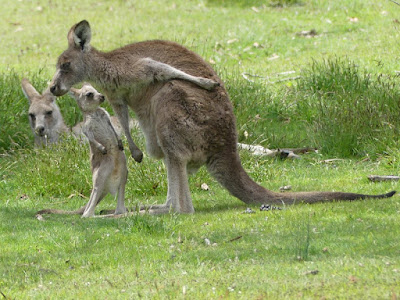 |
| Young joey, just out of the pouch. |
 |
| Looking north up the valley to the Tidbinbilla Range; the circuit road runs right along the foot of these mountains. |
 |
| Tidbinbilla in a very different mood - and this was in drought too, in 2015. |
 |
| Looking back to the north, out to the plains, from an elevated site along the drive. |
 |
| Tors in the Gibraltar Range, east of the valley. |
 |
| Views of the huge granite pile known as 'Hanging Rock', above and below, readily reached from a short walking track by the circuit drive. |
 |
| The shelter formed by a vast overhang; this area was doubtless of great significance to the people who lived in this area from at least 20,000 years ago, at the time of the last glaciation. |
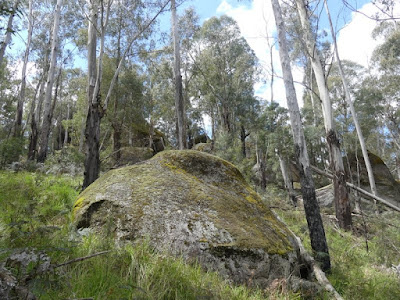 |
| Granite outcrops in Ribbon (or Manna) Gum, Eucalyptus viminalis forest. This is the dominant tree in much of the wet eucalypt forest on the lower slopes of the ranges. |
The drier forests have vegetation which is quite similar to that of the forested hills around Canberra, so the relatively few plant photos I have from Tidbinbilla are either in grasslands or the wet forests.
 |
| Yellow Rush Lily Tricoryne elatior in moist grassland behind the Visitors' Centre. |
 | |
| Parson's Bands Orchid Eriochilus cucullatus, also in wet grassland. |
 |
| Snowy Daisy Bush Olearia lirata. A small tree, one of the biggest daisies, gleaming white in the wet forest understorey in late spring. |
 |
| Bristly Helmet Orchid Corybas (or Corysanthes) hispidus. I love the strange little helmets, lurking in dim wet places, and mostly flowering in autumn or winter. |
 |
| Montane Leafy Greenhood Pterostylis (or Bunochilus) montanus. |
 |
| Summer Greenhood Pterostylis (or Diplodium) decurvum. |
 |
| Maroonhood Pterostylis pedunculata. This one can grow in colonies of hundreds of plants. |
 |
| Velvet Parachutes Marasmias (or Collybia) elegans growing from a burnt tree trunk. |
 |
| Yellow Navel Lichenomphalia (or Omphalina) chromacea. |
 |
| Puffball (any of several possible genera) 'puffing' out thousands of minute spores. |
 |
| Salmon Coral Fungus Ramaria formosa. |
Finally, to the Sanctuary. This was a great idea that arose from post-2003 fire recovery planning. Basically it took an existing substantial area of forest, already fenced to contain kangaroo species in particular (not all of which were native to the area) and greatly enhanced it through design. The fence is now predator-proof to allow reintroductions of locally extinct species such as bandicoots and potoroos and an existing weir on the Tidbinbilla River has been used to maintain a series of quite large downstream ponds. A 2.1km wheelchair-accessible walking track (plus side tracks) provides a circuit around the water and through the forest. There is an emphasis on education via signage - and originally strongly complemented by a large number of intensively trained volunteer guides. The excellent Australian Conservation Volunteers organisation provided high quality training and provided ongoing support for those who graduated.
It worked well but sadly financial exigencies, whether driven by necessity or changed priorities, drove the Department to bring the training and day to day operation in-house, with the result that the whole program collapsed. For some time there were no annual training intakes, no support and few if any of the scores of trained guides persevered. It was for a while a sad loss and a very false economy indeed, but I am assured that things have taken an upturn again (within the constraints of COVID) and there are again dedicated and trained volunteers, though not yet as many as before and they are not all deployed in the Sanctuary. However it is certainly an important step or two back in the right direction.
The eight million dollars spent on the original consultancy to plan and build the infrastructure was certainly not wasted and many visitors (including us) visit regularly.
 |
| Looking out from a viewing platform near the entrance to the Sanctuary, through the forest to the ponds. |
 |
| From there the track descends to pass alongside the ponds. |
 |
| Part of the excellent wheelchair-friendly track. |
 |
| This eagle is viewed through a gap in the roof of the shelter at the viewing platform mentioned above. |
 |
| Pelican, just metres from the water where the real ones live. |
 |
| Likewise the metal platypus. |
 |
| And Red-bellied Black Snakes, slow and placid (unless you're a frog or lizard) are regularly encountered along the walkway. |
However of course there are many other naturally occuring species that also thrive in the sanctuary. Some rely on the ponds and associated waterways. The most eagerly sought of these are the resident Platypuses - Tidbinbilla is without doubt the Platypus-sighting hotspot of the region. (Though a respected reader - see the first comment below - suggests the Queanbeyan River from weir to suspension bridge merits an equal claim. I won't argue.)
 |
| Australian Pelicans Pelecanus conspicillatus come and go, but some are generally present. This one was bathing vigorously to maintain good feather condition. |
 |
| Australian Reed Warblers Acrocephalus australis are annual migrants from the north, arriving in spring to breed in reed beds throughout the south-east, including Tidbinbilla. |
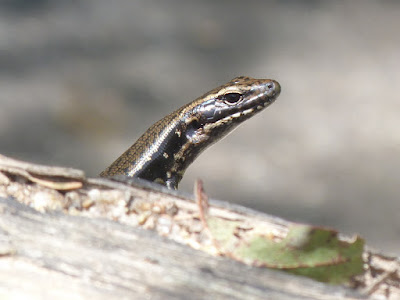 | |
| Southern (or Yellow-bellied) Water Skinks Eulampris heatwolei can be seen everywhere on warm days, flicking over logs and rocks, or just basking. Mostly they're pretty alert, like this one. |
 |
| Male Rufous Whistler Pachycephala rufiventris. Another spring migrant, breeding on the hills around Canberra and in the ranges. Their song is part of the spring soundtrack of Tidbinbilla. |
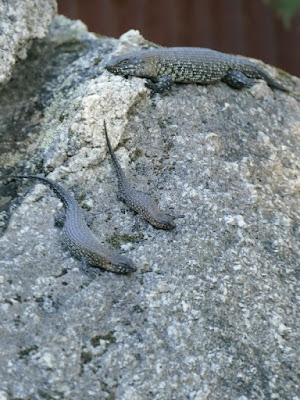 |
| They are also highly sociable, unlike most lizards, living in large social groups. |
I love to receive your comments and in future will be notifying you personally by email when a new posting appears, if you'd like me to. All current subscribers have been added to this mailing list and have already been contacted.
This will mean one email every three weeks at the current rate of posting.
Should you wish to be added to it, just send me an email at calochilus51@internode.on.net.
You can ask to be removed from the list at any time,
or could simply mark an email as Spam, so you won't see future ones.














